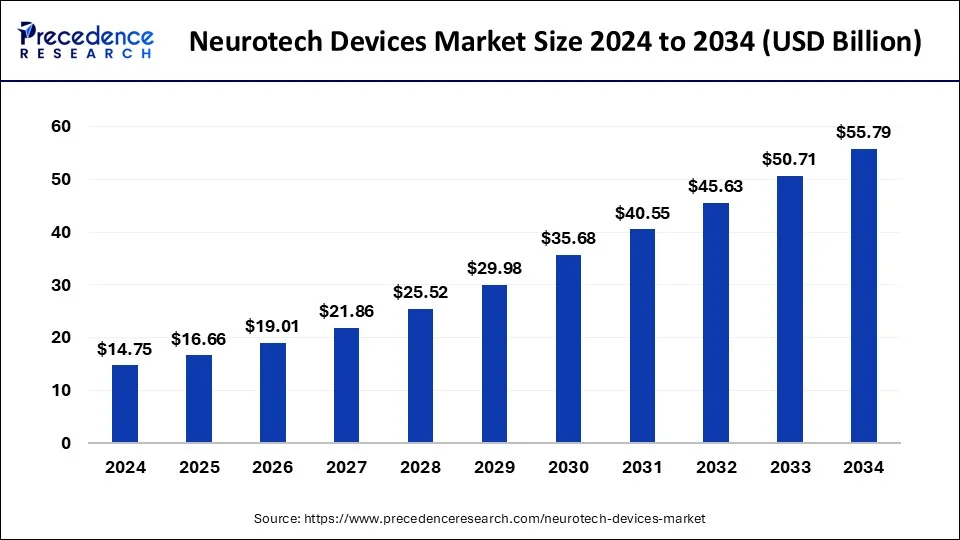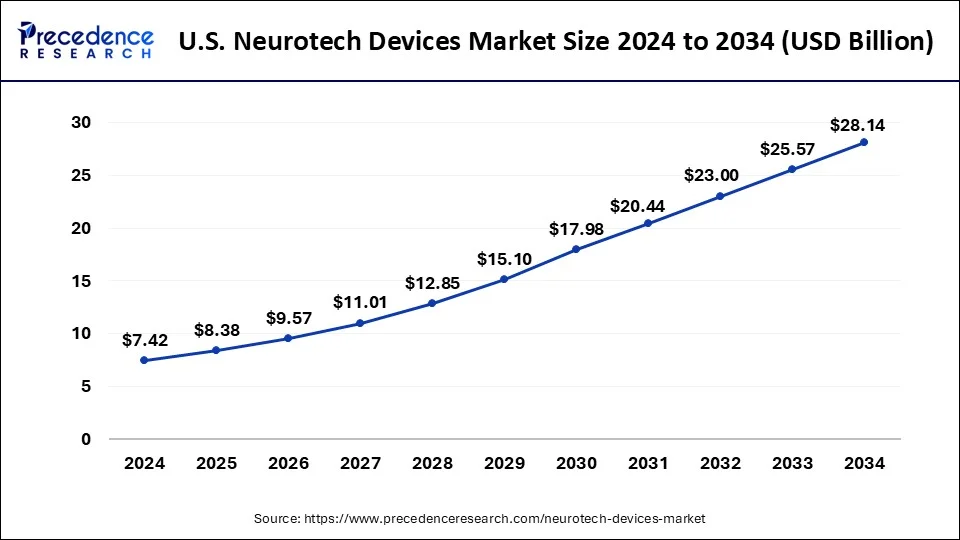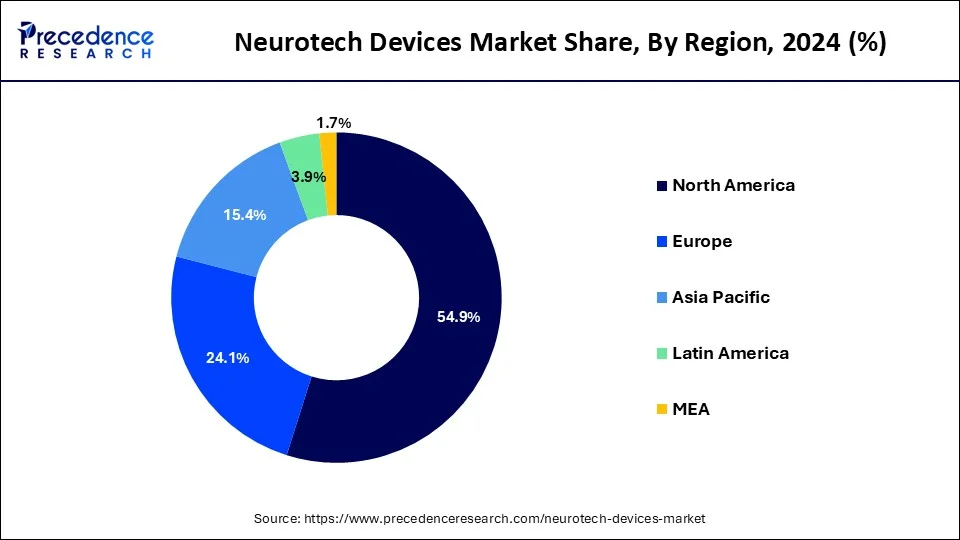April 2025
The global market size is calculated at USD 16.66 billion in 2025 and is forecasted to reach around USD 55.79 billion by 2034, accelerating at a CAGR of 14.37% from 2025 to 2034. The North America market size surpassed USD 8.09 billion in 2024 and is expanding at a CAGR of 14.30% during the forecast period. The market sizing and forecasts are revenue-based (USD Million/Billion), with 2024 as the base year.
The global ABC market size was estimated at USD 14.75 billion in 2024 and is predicted to increase from USD 16.66 billion in 2025 to approximately USD 55.79 billion by 2034, expanding at a CAGR of 14.37% from 2025 to 2034. The growth of the market can be attributed to the increasing adoption of neurotechnology devices in various medical applications, including neurological disorders treatment and rehabilitation.

The U.S. neurotech devices market size reached USD 7.42 billion in 2024 and is expected to be worth around USD 28.14 billion by 2034 at a CAGR of 14.40% from 2025 to 2034.

North America has dominated the global neurotech devices market in 2024. This dominance is supported by several factors, including substantial investments in research and development by both public and private sectors, favorable regulatory conditions that expedite product approvals, and a robust healthcare infrastructure. Moreover, the region benefits from a large pool of skilled neuroscientists and engineers. The prevalence of neurological disorders among the patient population further drives steady demand and growth in the market.
Asia Pacific is expected to see significant growth in the neurotech devices market during the forecast period. The significant growth is due to countries like China and India, where there's a surge in healthcare spending, increased public awareness about brain health, and government initiatives to modernize neurological care.

With a combined population exceeding 2.5 billion, these nations offer immense market potential. Local manufacturers are investing heavily in producing affordable neurotech solutions domestically by collaborating with multinational companies and adopting their technology. This effort is expanding access to neurotech solutions in rural areas and other regions across these countries.
Neurotechnology refers to any tech that deeply impacts the brain, thoughts, and consciousness. It covers tools that improve brain function, aiding both researchers and clinicians in visualizing and repairing brain issues. In the digital health realm, we're moving beyond simple tracking apps to complex medical devices. Cutting-edge tech is emerging, blurring the lines between computers and biology, with a focus on the brain. Neurotechnology includes brain-machine interfaces, neuroproteins, neurostimulation, and implantable devices, all aimed at enhancing and expanding our nervous system's abilities.
The neurotech devices market encompasses medical tools used to diagnose, prevent, and treat a wide range of neurological issues like Parkinson's disease, Alzheimer's disease, major depression, and brain injuries. The industry's growth is fueled by advancements in neuromodulation and neurostimulation techniques, which offer minimally invasive solutions to assist individuals.
| Report Coverage | Details |
| Market Size in 2025 | USD 14.75 Billion |
| Market Size by 2034 | USD 55.79 Billion |
| Market Growth Rate from 2025 to 2034 | CAGR of 14.37% |
| Base Year | 2024 |
| Forecast Period | 2025 to 2034 |
| Segments Covered | By Product Type, By Condition, and By End-user |
| Regions Covered | North America, Europe, Asia-Pacific, Latin America, and Middle East & Africa |
Rising incidence of neurological disorders
The increasing incidence of neurological disorders like epilepsy, Alzheimer's disease, and migraine has substantially raised the demand for innovative neurotechnological devices that help to improve the quality of patients' lives. This creates a steady demand for the neurotech devices market. The rise in the burden of neurological disorders is mainly linked to the geriatric population and the rise in life expectancy. As life expectancy increases, people are more prone to developing neurological diseases.
Rise associated with technological processes
Neurotechnology brings up ethical dilemmas related to concepts like our sense of self or soul, which are deeply philosophical and often taken for granted. One major area of ethical discussion revolves around the idea of personhood, a more modern concept that encompasses the fundamental aspects of our identity. The rise in the burden of neurological disorders is mainly linked to the geriatric population and the rise in life expectancy. As life expectancy increases, people are more prone to developing neurological diseases.
Neurotechnology is both captivating and contentious because it aims to connect human brains with machines directly. However, in the neurotech devices market, some of the new methods, like using light stimulation for hearing aids or targeted inhibition during epileptic seizures, come with significant drawbacks. These techniques involve genetically modifying normal nerve cells to express light receptors, which requires altering the cells' genetic makeup using manipulated viruses.
Growing R&D investments
The neurotech devices market has a lucrative growth opportunity for growth in the future using R&D investments. Market players and researchers are focusing more on gaining a deep understanding of the nervous system and human brain-related conditions. These medical conditions create a global health challenge, with more than a billion people anticipated to be living with neurological disorders.
A lack of proper treatment for these diseases indicates the need for proper diagnosis. The multidisciplinary collaborations between engineers, data analysts, and medical experts are giving breakthroughs in the industry. This creates new opportunities for major players in the neurotech devices market.
Technological advancements and compatibility
Current research is focused on improving the long-term stability and compatibility of brain implants to make them suitable for everyday use, not just in clinical trials. Recording electrodes placed deep inside the brain can provide more accurate and specific data, but this method is invasive because it requires penetrating brain tissue. Applications like controlling complex devices, such as prosthetic arms with grippers, using brain activity are included in the neurotech devices market. To improve the accuracy and reliability of these prostheses, engineers are looking to modern robotics and machine learning tools to make them adaptive and intelligent. This would enable them to perform tasks more effectively and even anticipate the patient's intentions without detailed control.
The neurostimulation segment dominated the neurotech devices market in 2024. The segment includes the spinal cord, vagus nerve stimulators, deep brain, and spinal cord, along with the electrical nerve stimulations. The dominance of the segment is linked to the rise in R&D activities along with the launches of new and better products for treatment. These factors contribute to the market expansion.
In the neurotech devices market, the neuroprostheses segment is expected to show substantial growth over the forecast period. Neuroprostheses can restore sensory, motor, and some autonomic functions by stimulating different parts of the CNS, including the spinal cord, nerves, and the brain.
Neurotech Devices Market Revenue, By Product 2022-2024 (USD Million)
| Product | 2022 | 2023 | 2024 |
| Neurostimulation | 8,285.6 | 9,058.4 | 9,960.8 |
| Neuroprostheses | 2,376.8 | 2,615.7 | 2,904.0 |
| Neurosensing | 345.2 | 396.7 | 459.2 |
| Neurorehabilitation Devices | 1,052.0 | 1,218.6 | 1,421.7 |
The pain management segment held the largest share in the neurotech devices market. Pain management drugs help ease discomfort from injuries, diseases, chronic conditions, and surgeries. They work by targeting inflammation caused by chemical agents, infections, or nerve damage. These drugs temporarily change the body's biochemical functions to provide relief. They can be tailored to specific organs or cells due to the protein content of certain tissues.
Pain management drugs come in over-the-counter and prescription forms to address various conditions. Over-the-counter options are good for relieving muscle aches, headaches, and arthritis. Prescription medications offer stronger relief for persistent or severe pain after injury or surgery. Opioids, some anti depressed and anti-seizure drugs, can also help alleviate pain.
The hospital segment held a significant share of the neurotech devices market in 2024. The rise in hospital admissions globally, combined with suitable reimbursement policies for surgeries performed in hospitals, is the major factor contributing to the growth of the market. Hospitals are also equipped with various innovative equipment to make smoother minimally invasive neurological treatments for patient care and management. Furthermore, hospitals provide safe, quick, and efficient treatments for better patient outcomes.
Neurotech Devices Market Revenue, By End-use 2022-2024 (USD Million)
| End-use | 2022 | 2023 | 2024 |
| Hospitals | 4,792.4 | 5,245.1 | 5,780.2 |
| ASCs | 3,296.5 | 3,653.3 | 4,076.6 |
| Homecare Facilites | 2,409.2 | 2,681.7 | 3,005.5 |
| Others | 1,561.6 | 1,709.4 | 1,883.2 |
By Product Type
By Condition
By End-user
By Geography
For inquiries regarding discounts, bulk purchases, or customization requests, please contact us at sales@precedenceresearch.com
No cookie-cutter, only authentic analysis – take the 1st step to become a Precedence Research client
April 2025
January 2025
January 2025
February 2025